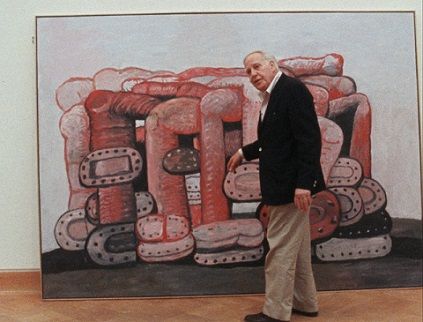
"Painting and sculpture are very archaic forms. It's the only thing left in our industrial society where an individual alone can make something with not just his own hands, but brains, imagination, heart maybe."
Philip Guston was born Philip Goldstein, in Montreal, Canada, in 1913. He was the youngest of seven children born to a Jewish couple who had come to America after fleeing the pogroms in Russia. America seemed to offer shelter from persecution, yet the family found life difficult in their new country. Guston's father had been a saloon keeper, but he struggled to find work; in 1919 the family moved to Los Angeles with hopes of better fortunes, but they only encountered more hardship and also met with the racism that surrounded the growth of the Klu Klux Klan in the period. Around four years later, his father committed suicide by hanging and Guston discovered the body, an experience which profoundly marked him. As he moved into adolescence, Philip retreated in the fantasy world of comics, and started to become interested in drawing, which led his mother to enrol him in a correspondence course at the Cleveland School of Cartooning, thus beginning his training as an artist.
In a career of constant struggle and evolution, Philip Guston emerged first in the 1930s as a social realist painter of murals in the 1930s. Much later he also evolved a unique and highly influential style of cartoon realism. But he made his name as an Abstract Expressionist. He avoided the muscular gestures of painters such as Pollock and Kline, and opted for a lighter touch, painting shimmering abstractions in which forms seem to hover like mists in the foreground. Philip was a notable painter and printmaker in the New York School, an informal group of American poets, painters, dancers, and musicians active in the 1950s, 1960s in New York City. which included many of the Abstract expressionists, such as Jackson Pollock and Willem De Kooning. In the late 1960s Guston helped to lead a transition from Abstract Expressionism to Neo Expressionism in painting, abandoning the so-called "pure abstraction" of abstract expressionism in favor of more cartoonish renderings of various personal symbols and objects.
Guston was perhaps the most politically driven of all those artists who later went on to become abstract expressionists. He produced anti-fascist paintings; secured prestigious public mural commissions under the New Deal; and, unlike any of the others, his interest in mural art drew him to Mexico. The attempt to understand this shift from a politically radical art practice in his earlier years through to an abstract one by the 1950s entails a closer examination of the fortunes of the US Communist Party (CPUSA) in the period of the Popular Front, the influence it had upon young artists radicalised by the Depression, and the move from a federally sponsored mural art of the New Deal period through to the post-war consolidation of the commercial gallery system.
The Work
"BOMBARDMENT"
1937-38
OIL ON MASONITE

Philip painted Bombardment after reading newspaper reports of the atrocities carried out during the Spanish Civil War, which began on July 17, 1936, When General Francisco Franco led a military coup against the democratically elected Republican government. The emotionally charged scene, which reflects the artists recent exposure to the activist art of the Mexican mural movement, depicts the areal bombardment of a civilian population by Francos war planes. However, the traditional tondo (circle) format, typically identified with italian Renaissance painting suggest that Guston intended to create a universal icon decrying human hatred and destruction rather than a specific commentary on the war in Spain.
My Reaction
At first glance I was immediately moved by this piece. It's as if I'm peeking into the past frozen in time.
Guston vividly displayed his vision of fear, chaos, and terror with great composition and use of positioning. I like how he put detail in everything from the brick wall on the left to the bombs exploding in the middle ground and the people in the background running for cover. It definitely feels as if I'm watching happen and time just stopped.
Work Cited
http://www.permanentrevolution.net/entry/738 Workers Power 285 - April 2004
http://www.theartstory.org/artist-guston-philip.htm
Dennison ,Lisa. Celant, Germano, "NEW YORK NEW YORK". SHIRA EDITORE. S. p. A. Palazzo Casati Stampa via Torino 61 20123 Milano Italy 2006. Print
Dennison ,Lisa. Celant, Germano, "NEW YORK NEW YORK". SHIRA EDITORE. S. p. A. Palazzo Casati Stampa via Torino 61 20123 Milano Italy 2006. Print


